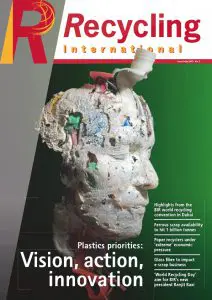Page 46 from: June / July 2015

JOIN US FOR
SEPTEMBER 1–3, 2015
ORLANDO, FL • OMNI CHAMPIONSGATE
w w w . e – s c r a p c o n f e r e n c e . c o m
Benefi ts of the Recycling International
app include:
• Access to international recycling trends and
developments;
• The opportunity to browse your favourite
sections and articles; to fi nd out all about
business developments, recycling technology or
market movements; and to view image galleries
and videos, and follow links easily.
www.recyclinginternational.com
At your fi ngertips:
The latest, vital information about
the global recycling industry
23June/July 2015
ing status for China and South Korea.
BIR ferrous division president William
Schmiedel of Sims Metal Management
Global Trade Corporation in the USA
emphasised that China remained a
major factor in the marketplace. ‘The key
number to watch is the amount of Chi-
nese exports of fi nished and semi-fi n-
ished steel which, while radically
decreasing in February and March,
bounced back to over 8.5 million tons
in April, which is a 15% increase over
March.’ Chinese exports in April exceed-
ed total US production, he pointed out.
Returning to the issue of transfrontier
scrap shipments, the meeting learned
that the Ukrainian government was
attempting to make the distribution of
scrap export quotas ‘more transparent’
but that this was ‘a slow process’.
Reasons to be cheerful
but also concerned
Athough a number of market reporters
were lamenting a general lack of scrap,
the World Steel Association’s director
general Dr Edwin Basson injected a
large measure of cheer into the latest
meeting of the BIR ferrous division.
The guest speaker in Dubai coupled a
prediction that global demand for fer-
rous scrap for steelmaking would
increase by around 110 million tonnes
between 2014 and 2019 with an asser-
tion that the electric arc furnace share
B I R D U B A I By Ian Martin
of global steel production
would climb from 27% to
30% over the same peri-
od. Scrap demand growth
would be driven by China
and Turkey, as well as by
the ASEAN and NAFTA
regions, he added.
As regards global demand
for fi nished steel, Basson
forecast a surge of around
25% from 1.537 billion tonnes last
year to 2.101 billion tonnes by the year
2040, adding that ‘close to half will be
produced using scrap’. He also envis-
aged that global scrap availability
would climb from around 700 million
tonnes at present to hit 1 billion tonnes
in the late 2020s.
Scrap ‘fl ood’ unlikely
According to Basson, it was logical for
basic oxygen furnace steelmakers to
make use of scrap when energy costs
were high. So while he believed China
would become a net scrap exporter in
around eight to 10 years from now, he
did not expect the country to unleash
‘a fl ood’ into the export channel.
However, the transformation of China –
and also South Korea – into steel scrap
exporters over the coming years will have
signifi cant implications for international
trade. For example, Hisatoshi Kojo of
Metz Corporation acknowledged recent
Japanese scrap offers into Turkey, adding
that his country’s exporters would need
to fi nd new customers given this chang-
Shredder operators must plan for
‘batteries in everything’
The growing use of electronics in
almost every conceivable walk of life
is increasing the fi re risk for shred-
der operators. However, the problem
can be minimised through good
management, it was emphasised to
the BIR shredder committee meeting
in Dubai by George Adams of SA
Recycling in the USA.
Operators were confronted with the
challenge of ‘batteries in every-
thing’, he told delegates, with those
containing lithium posing a particu-
lar problem because exposure of the
metal would generally lead to a fi re.
Given that fires in large piles of
scrap were particularly
diffi cult to bring under
control, he urged oper-
ators to ‘shred every
day’ or to create small-
er piles separated
according to product
type. Any pile compris-
ing more than 250
tonnes of feed material could prove
diffi cult to pull apart in the event of
a fi re, he pointed out.
The meeting also saw the launch of
a BIR brochure entitled ‘Benefi ts of
using shredded ferrous scrap in steel
mills and foundries’ which outlines
the economic, operational and envi-
ronmental benefi ts of shredded over
other scrap types, including: a reduc-
tion in CO2 emissions and in slag
production; shorter melting times;
and faster loading for inland water
and deep-sea transportation.
It was also confi rmed in Dubai that a
signifi cant number of shredders in
Europe and the USA
had been mothballed in
recent months. Lack of
volume was given as a
key reason for closures
in the USA – ‘especially
if a company has two
shredders in the same
geographical area’.
The BIR ferrous division meeting in
Dubai saw the launch of the 6th edi-
tion of its ‘World Steel Recycling in
Figures’ statistical brochure, further
details of which can be found in the
ferrous market report of this issue of
Recycling International.
Ferrous
George Adams.
It was underlined at the BIR ferrous division meeting in Dubai that a sustained improvement in the steel scrap industry depended upon a
‘healthy and buoyant’ steelmaking sector. In this context, a leading
steel industry representative was prepared to envision a ‘healthy’
future but regarded hopes of ‘buoyancy’ as perhaps a step too far.
William Schmiedel:
China remains major factor.
Dr. Edwin Basson: global scrap
availability to climb.
RI 5-BIR ferrous and shredder.indd 23 15-06-15 09:34
14
Vision is vital,
bu so are action
d innovation
Opaque, black and multi-layer plastics are jamming the wheel of progress, prompt-
ing more companies to eye the latest in sorting
technologies. ‘If MRFs are equipped with the
latest high-performance optical sorters, such
contamination can be eliminated even before
it arrives at the recycling plant, and our ulti-
mate aim of achieving a quality close to virgin
material can be realised,’ delegates to the recent
IdentiPlast conference in Rome were told by
Jonathan Clarke, global sales director of Tomra
Sorting Recycling.
The ‘next-generation’ sorting solutions such
as the ones produced by Tomra can detect
up to 90% of material, including black plastics
without carbon, aluminium labels and trans-
lucid plastics. According to Dr Pietro Spagni,
recyclers in Italy could only dream of such
performance levels back in 1993 when the
first sorting plant was opened. The man run-
ning the plastics systems division of IdealSer-
vice added: ‘The capacity of our first sorting
plants was 3000 tonnes per year and all the
bottles were manually sorted. We had to
start from scratch. But things have changed for
the better.’
Plastics-hungry
There are now 30 sorting plants across Italy
while around 800 000 tonnes of plastic was
collected in 2013 by the national plastic waste
management consortium Corepla, with bottles
making up roughly one-third. Two decades
earlier, the overall collection total had been a
mere 55 000 tonnes, with the change coming
about because local authorities were called
upon to organise collection activities. ‘A driver
for them is that the fees they receive are direct-
ly related to the quality of the material,’ Spagni
added. On average every year, Italy collects
14 kg of plastics per inhabitant for recycling.
Veneto, the country’s fifth most populous
region, has even managed to collect up to 20 kg
per person per year. The country’s lowest col-
lection rate (3.4 kg per annum) has been
obtained in Calabria.
Across Europe, plastics demand equals 46.1
million tonnes per year – two-thirds of which
is concentrated in five countries; Italy is the
runner-up among the most plastics-hungry
nations, providing 14.3% of the total demand
in 2013 compared to Germany in first place on
more than 25%. Plastic packaging accounted
for no less than 40% of this demand.
C O V E R S T O R Y By Kirstin Linnenkoper
Rome host to plastics debate
‘We are between a rock and a hard place,’ stated Jonathan Clarke
at the recent IdentiPlast conference in the ancient city of Rome.
Over the last year, the recycled PET sector has faced up to an oil
price drop of more than 50% such that virgin PET now costs less
than recycled material. And conditions appear unlikely to change in
the comi g months, suggested the Tomra Sorting representative.
But as the rain cleared from grey late-April skies, the sharing of
global success tories served to balance the mood among delegates.
RI_5-IdentiPlast.indd 14 15-06-15 09:26
46 AD.indd 1 15-06-15 09:49



